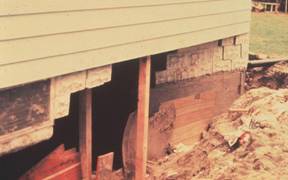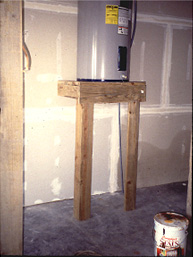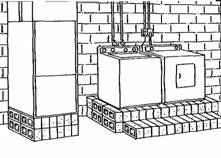Protect Your House
There are many ways you can protect your home, garage or other property from the types of flood damage experienced in South Holland. Different techniques are appropriate for different types of buildings.
It is important to note that these protection measures are for existing buildings. There are different requirements for new buildings. These measures will not relieve you from the need to buy flood insurance if your building is in a mapped floodplain.
If your house is on a crawlspace:
– Look into barriers, and wet floodproofing
If your house is on a slab foundation:
– Check out barriers and dry floodproofing
If you have a basement, split level, or other floor below ground level
– Learn about barriers, wet floodproofing, and basement protection
 | Additional information is available from FEMA publications, including Homeowner’s Guide to Retrofitting: Six Ways to protect Your House from Flooding. Another good publication is Protecting Building Utilities From Flood Damage. These references can be found at http://www.fema.gov/protecting-homes or at the South Holland Public Library. |
Disclaimer:
This information is designed to give you an overview of steps that can be taken to protect a property from damage from the type of surface water flooding and sewer backup that faces South Holland. The information provided is based on careful research and input from experienced professionals. You must assume responsibility for adapting this information to fit your conditions. This guide is not intended to replace the advice and guidance of an experienced professional who is able to examine a building and assess the needs of the particular situation.
Barriers
Barriers keep surface floodwaters from reaching a building. A barrier can be built of dirt or soil (“berm”) or concrete or steel (“floodwall”). The standard design for earthen berms is three horizontal feet on each side for each vertical foot (3:1 slope). As a result, you should plan on needing an area six feet wide (at a minimum) for each foot in height.
 This berm protects the home from flooding from the stream to the left. |  This home on the Little Calumet River has a floodwall to protect it from low level flooding. |
Depending on how porous your ground is, if floodwaters will stay up for more than an hour or two, your barrier will need to handle leaks, seepage of water underneath, and rainwater that falls inside the perimeter. You will need a sump and/or drain to collect the internal groundwater and surface water. A pump and pipe is also needed to pump the internal drainage over the barrier.
A berm or floodwall should be as far from the building as possible to reduce the threat of seepage and hydrostatic pressure. However, it must not interfere with drainage along your property line. Where the house is close to the property line, you may need place the berm next to the wall, like a basement protection berm.
Don’t forget: a permit is needed for filling or regrading a yard. There may be restrictions on bringing fill onto your site if it blocks the flow of flooding or displaces floodwater storage areas. For example, state regulations require that barriers located within the regulatory floodway be within ten feet of the structure.
Precautions: Barriers can only be built so high. They can be overtopped by a flood higher than expected. Earthen berms are susceptible to erosion from rain and floodwaters if they are not properly sloped and covered with grass and maintained. Don’t plant trees or shrubs on a berm (their roots can cause leaks). Barriers can settle over time, lowering their protection levels.
Some barriers have openings for driveways and sidewalks. Closing these openings is dependent on someone being available and strong enough to put the closure in place. You also need to account for water in the sewer lines that may back up under the barrier and flood inside your house.
Dry Floodproofing
This term covers several techniques for sealing up a building to ensure that floodwaters cannot get inside it. For dry floodproofing, all areas below the flood protection level are made watertight. Walls are coated with waterproofing compounds or plastic sheeting. Openings (doors, windows, and vents) are closed, either permanently, with removable shields, or with sandbags. Many dry floodproofed buildings do not look any different from those that have not been modified.
Dry floodproofing is only appropriate for buildings on concrete slab floors (without basements) and with no cracks. To ensure that the slab is watertight and sound, an engineering analysis is recommended.
The maximum flood protection level is two feet above the slab. The walls and slab floor were not built to withstand the type of pressures exerted by deeper water. It is smarter to let deep water into your house than to risk losing your walls or floor.
 These walls were sealed with plastic sheeting covered by brick facing for protection from sunlight and punctures. |  Dry floodproofing is not recommended for keeping surface water out of a basement. The water pressure can break the walls and floor. |
Precautions: It is very tempting for the owner of a dry floodproofed building to try to keep the flood out if floodwaters get deeper than two or three feet. This can result in collapsed walls, buckled floors, and danger to the occupants.
It is difficult to waterproof a crawl space to protect it from underseepage. Basements should not be dry floodproofed to protect them from surface flooding because of the water pressure on the walls and floors. See the basement protection berm for an alternative approach.
Many commercial waterproofing compounds are made to protect wood from rain, but they will not withstand the pressures of standing water. Some deteriorate over time, so check with the supplier to be sure the waterproofing compound is appropriate for sealing your basement walls from water. Installing closures and seals over doors and windows requires enough warning and having someone at the building who knows what to do.
Wet Floodproofing

This wet floodproofed garage has bare concrete,
unfinished drywall (for fire protection) and an elevated water heater.
Wet floodproofing means letting the water in and removing everything that could be damaged by a flood. There are several ways to modify a building so that floodwaters are allowed inside, but minimal damage is done to the building and its contents. These techniques range from moving a few valuable items to rebuilding the floodprone area.
In the latter case, structural components below the flood level are replaced with materials that are not subject to water damage. For example, concrete block walls are used instead of wooden studs and gypsum wallboard. The furnace, water heater, and laundry facilities are permanently relocated to a higher floor. Another approach is to raise these items on blocks or platforms where the flooding is not deep (see photo).
Wet floodproofing is not feasible for one-story houses because the flooded areas are the living areas. However, many people wet floodproof their basements, garages, and accessory buildings simply by relocating all hard-to-move valuables, such as heavy furniture and electrical outlets. Light or moveable items, like lawn furniture and bicycles, can be moved if there is enough warning. Fuse and electric breaker boxes should be located so you can safely turn the power off to the circuits serving floodprone areas.

Even a minor wet floodproofing project
will reduce flood losses to a home.
Another approach is to wet floodproof a crawlspace. If your crawlspace has a furnace in it or is used for storage, these items could be moved to the first or second floor. Vents should be placed on the foundation walls to ensure that floodwaters can get into the crawlspace to equalize water pressure.
Wet floodproofing has one advantage over the other approaches: no matter how little you do, you will reduce your potential for damage. Thousands of dollars in damage can be prevented by simply moving furniture and electrical appliances out of a basement.
Precautions: Moving contents is dependent on adequate warning and the presence of someone who knows what to do. Flooding a basement or garage where there is electricity, paint, gasoline, pesticides, or other hazardous materials creates a safety hazard. There will still be a need for cleanup, with its accompanying health problems.
Moving water lines, furnaces, or electric service boxes requires a permit from the Planning and Development Department.

